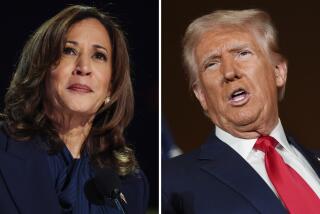Give Tax Plan a Head Start in Congress
- Share via
On Wednesday, Texas Gov. George W. Bush announced his tax plan. Clearly, he believes that a big tax cut will help him win both the Republican nomination and ultimately the presidency.
Whether Bush’s tax plan proves to be a plus or a minus for his campaign is going to depend vitally on how he sells it and whether people believe he is serious about it. After all, he comes to the tax issue with a credibility problem because his father, President Bush, broke his pledge not to raise taxes in 1990. In an interview with the Wall Street Journal, Bush the younger conceded that this was a major factor in his father’s defeat in 1992. Even without his father’s baggage, Bush has a larger problem, which is that Americans don’t believe any politician when they promise tax cuts. According to a Fox News/Opinion Dynamics Poll in March, only 9% of Americans believe a politician promising tax cuts; 87% say they do not.
So how can Bush make Americans want a big tax cut and believe he will really cut taxes if elected? He can start by treating his tax plan not as something that won’t happen until 2002 at the earliest, but as something that should be enacted now. Bush can do this by asking his supporters in Congress to introduce his plan as legislation when it reconvenes in January. They should hold hearings, have relevant agencies such as the Congressional Budget Office do studies and schedule a vote in the spring.
There is precedent for this. In 1980, Republicans in Congress coordinated their efforts with Ronald Reagan’s campaign and pushed for immediate passage of his 30% tax-rate reduction. The effort was doomed to failure, with Democrats still in control of the White House and both houses of Congress. But the effort was important in showing voters that Reagan was serious about his plan. Also, the early debate on Reagan’s tax plan smoothed the way for ultimate passage in 1981.
Since then, voters have been burned by presidential promises of tax cuts. In 1992, Bill Clinton promised a tax cut for the middle class and then reneged once elected. In 1996, Bob Dole reversed a lifetime of supporting tax increases in proposing a 15% tax-rate reduction. He clearly never believed in the plan and this eventually came through to voters, contributing to his defeat. By pushing for his tax cut now, Bush will show that he is not promising pie-in-the-sky, but something tangible. It will show that he is committed to his plan in a way that Dole never was.
Of course, it may be that there really is no base of support for a tax cut, no matter how credible. This will require some marketing savvy. However, a new poll from Zogby International for the White House Bulletin shows the way. Voters were asked: “The U.S. Government will take in $3 trillion over the next 15 years that it currently has no plans to spend. Do you want to keep some of the money in the form of a tax cut or have the government make plans to spend it on federal programs?” In response, 56.3% of voters favored a tax cut and only 31% wanted more spending. Even Democrats split almost evenly on the question, with 41.8% wanting a tax cut and 44.7% favoring spending. Thus, framing the debate as either a tax cut or more spending will be critical to the success of Bush’s tax plan.
Bush’s tax plan has the potential of being a winning issue for him, but he must convince voters he really believes in it. He should enlist the aid of his friends in Congress and at least begin the process of pushing it toward enactment. That will go a long way toward giving Bush credibility on the tax issue, which may be the biggest obstacle he has to overcome.
More to Read
Get the L.A. Times Politics newsletter
Deeply reported insights into legislation, politics and policy from Sacramento, Washington and beyond. In your inbox twice per week.
You may occasionally receive promotional content from the Los Angeles Times.










